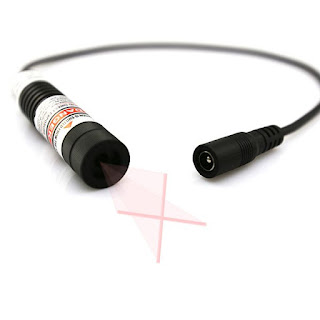Based on the use of advanced 405nm laser diode tech and a qualified optic lens inside a durable anodized aluminum alloy housing tube, it is manufacturing into a professional dot measuring tool of a 405nm violet laser diode module. Among all visible optical spectrum, it gets short wavelength of 405nm, which allows for focusing into a small spot, making it suitable for high precision inspection and micromachining, meeting the industrial demands for processing and inspecting tiny components. This 405nm violet dot laser always enables high energy density violet laser light source concentration and efficient conversion of increasing accuracy and brightness violet dot projection at long extending distance conveniently.
The usual use of a 405nm violet laser diode module applies an import 405nm violet laser diode as its beam emitting source, getting selected output power of 50mW to 100mW, and high power up to 150mW to 200mW. The near ultra violet laser light possesses sufficient energy to excite excite fluorescent materials or initiate photochemical reactions in photosensitive materials, making it suitable for applications such as fluorescence excitation and photocuring. This is a feature that cannot be replaced by other laser modules with other wavelengths. Compatible with certain materials' absorption characteristics: Certain metals, such as copper and gold, violet dot laser alignments have a high absorption rate for 405nm wavelength lasers, offering advantages in welding and other processes involving these materials, effectively increasing welding speed and improving welding results.
Owing to the special use of a qualified glass coated lens, the genuine use of a 405nm violet laser diode module enables small size violet dot projection and high resolution improvement in manufacturing accuracy and yield of fine wires in imaging systems. It enables more accurate dot alignment for multiple layer PCBS and meets the high precision requirements of industrial production. Besides the adoption of an import 405nm violet laser diode, this violet dot laser also utilizes APC, ACC driving circuit board, which ensures the good exhibition of low temperature drift and high stability, and long time stable operation. It enables long serving lifetime of more than 8,000hours, reduced maintenance cost and improved production efficiency.
Featured by ultra compact structure and ultra compact size, the usual use of a 405nm violet laser diode module is highly compatible with other industrial machine or device, which is easy to integrate into various industrial equipment. This allows manufacturers to design and install them according to their needs, and their modular structure facilitates future maintenance and upgrades. Owing to easy screw of adjustable focus optic lens design and adjusted violet dot projecting direction within three dimensional space, this violet dot laser alignment also meets the requirements of various industrial scenarios.
Applications:
PCB Inspection and Platemaking: 405nm violet laser diode module can be used in laser direct imaging (LDI) equipment used in PCB platemaking, achieving submicron exposure accuracy and precisely engraving complex circuit patterns. It is suitable for processing high-frequency PCBs for 5G base stations and high-density packaging boards for AI chips. They can also be used for PCB inspection, leveraging their short wavelength characteristics to detect subtle defects on the circuit boards.
Photolithography: Violet dot laser can be used in the manufacture of semiconductors, flat panel displays, MEMS/MOEMS, and other microelectronic components, achieving high-precision and uniform line exposure. They can also be used for light rotation of high-speed gears, ink bonding and stripping, and gate processing of coated surfaces.
Photocuring: 405nm violet alignment lasers fall within the near-ultraviolet (UVA) range and possess high photon energy. They can be used to cure certain photosensitive resins, such as in 3D printing, where they can rapidly cure and form complex structures.
Industrial Online Quality Inspection: Its wavelength resonates with the absorption spectrum of many gases, solids, and liquids, enabling applications such as online chemical reaction monitoring and semiconductor casting quality inspection. The absorption spectrum can be used to determine the composition or state of a material.
Positioning and Indication: 405nm violet dot laser can be used as an alignment and light source indicator for applications such as garment machinery and tunnel lighting, helping workers operate accurately and improving production efficiency and accuracy.


